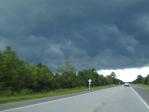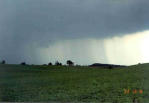The Ecotone wiki site is a collection of essays on "place" and its meaning to the writers. My other bursts of
place-idity:
Cemeteries
Coffeehouses
Courage
Coming & going
Food & place
Imaginary place
Islands
Maps as place
Mythical place
Placenames
River and Estuary
Rocks and place
Saving place
Sea
Sound and place
Spider
Secret
Time
Trees
Visitors & place
One of the enduring mental images of my years in Central New York I saw as I was waiting for a traffic light near my home. It was July 3 or 4 and the day was hot and oppressive. But as I sat, sweating in my hot car, I could see a thunderstorm building beyond the commercial buildings around me. It already blocked the sun, and an area of frightening black was spreading beneath the cloud.
for a traffic light near my home. It was July 3 or 4 and the day was hot and oppressive. But as I sat, sweating in my hot car, I could see a thunderstorm building beyond the commercial buildings around me. It already blocked the sun, and an area of frightening black was spreading beneath the cloud.
Against that fearsome dark, there rose a Roman candle. It arced up, across the black, and popped squarely in the middle of my line of sight.
Wow, I thought. What a metaphor for defiance in the face of overwhelming might -- or else for human futility in the face of nature.
Where I come from in the Catskills, thunderstorms have a certain dignity. Half the time, a summer storm never makes it to your side of the mountain in the first place, but when it does, it savors each peal of thunder -- FLASH/BOOM tick tick tick FLASH/BOOM tick tick tick, as if to conserve its limited energies. And, given the effort involved in shoving a storm sideways across a range of hills and valleys, those energies are limited.
Central New York seemed to generate downpours -- a certain amount of thunder and lightning, but accompanied by gully-washers that seemed to be solid water. I spent my 30th birthday huddled under a dining fly in the midst of such a downpour -- messy but survivable.
Nothing in my New York experience prepared me for Ohio storms. They don't fool around out here.
The first time one caught us out of doors, my wife and I th ought to settle into our car in a sheltered spot and watch it go by. By and by we noticed it seemed to have a halo of lightning. It was sparking away like a Van de Graaf generator, in all directions, and the noise from it was prodigal and continuous. It looked a bit like a Keystone Kops scene with the Kops coming on, hanging off all the sides of a car and waving their arms and nightsticks -- except lightning is not to be trifled with. We were spooked, and we drove away from there.
ought to settle into our car in a sheltered spot and watch it go by. By and by we noticed it seemed to have a halo of lightning. It was sparking away like a Van de Graaf generator, in all directions, and the noise from it was prodigal and continuous. It looked a bit like a Keystone Kops scene with the Kops coming on, hanging off all the sides of a car and waving their arms and nightsticks -- except lightning is not to be trifled with. We were spooked, and we drove away from there.
These energetic boomers rattle through Cleveland regularly. You can hear them far away at night -- boom, boom, boombity boom, boombity, boombity boom. If you've ever kicked, or imagined kicking, a garbage can down a long stretch of park stairs, you'll know what it sounds like. Doomed to wakefulness for the next hour, you lie in bed and wonder if you should close the windows, wonder if the cars are buttoned up, wonder if there will be damage. And all around you lies the close dark, giving no answers but boombity, boombity.
Local television tries to improve on these post-midnight wonderings. They're up to "triple Doppler" weather radar now, and with it, they can point to the spots where the storm is (gasp!) BEGINNING TO ROTATE (so kiss your roof, and your a--, goodbye!).
The fact is, thunderstorms often rotate. If the circle gets tight enough and the action intense enough, you can get a funnel cloud. If the funnel cloud gets big enough, you have a problem. The TV people, not unaware that tornadoes generate excitement, always want to be first to point them out -- so the hype quotient gets really high.
I do n't have to listen to Channel 5 to know I'm not in the Catskills anymore. I can hear the proof itself rattling across the city on its way from somewhere to somewhere else.
n't have to listen to Channel 5 to know I'm not in the Catskills anymore. I can hear the proof itself rattling across the city on its way from somewhere to somewhere else.
But this year, I have twice seen something truly Midwestern, and unlike anything else I have ever seen elsewhere -- spent thunderstorms.
It stands to reason, of course, that thunderstorm cells would eventually wear out, lose their moisture and their energy and go back to being ordinary air -- just as an eddy in around the pilings of a pier might swirl and drag a little junk around before going back to being ordinary, calm water. But I had never seen it until I drove along Ohio's Interstate highways an hour after a front passed through.
Hanging in the moist air to one side of the road was a fluffy, disorganized cloud. Below it hung the veil of mist that indicated it was still raining -- but was it? The veil looked like an ice-cream scoop, hollow in the middle and curled to one side, and after staring a while (for what else do you have to do on an Interstate when the traffic is quiet?) I realized that the air in the center of the hollow was rising still, and gently pulling the mist, and probably any remaining rain, with it. Exhausted, the cloud had rained itself out and was waiting to be scooped up by some more energetic one.
A couple of months later, I saw the phenomenon again. This time, over the flat lands near Toledo, I could watch for miles as the setting sun picked out a couple of great circles of cloud. Golden in the last sunlight, with blue sky beyond them, they seemed utterly calm, but I thought they could only have been formed by considerable violence, and I guessed the circular strip must be at the edge of the dying eddy. Far beyond, the same sunlight caught the tops of new thunderheads rolling across the plains. The scene was magestic and vast, with small, shiny traffic pouring along the highway, green fields and forests beyond, the blue and gold of the spent clouds leading the eye to the white and gray of the active ones far in the distance.
I'd like to say my spirit rose and expanded with the vision. Actually, my overtired daughter was melting down in the back seat and I was busy managing my self-control. If all that was God's way of protecting the girl from some dire punishment I never actually thought of, all I can say is that He went to a lot of trouble. I hope that someday she will appreciate it.